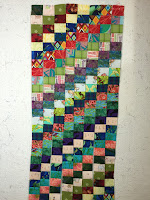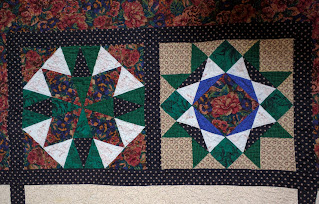There are two ways I to make Trip Around the World: use individual squares or strips. The first gives you complete control but takes a while. The second can be both more random and more organized. It may also yield unexpected results.
 |
| Scrappy Mini Trips from strips on the left and using individual squares on the right |
Many people make tubes of six or eight strips, cut them crosswise and unsew between the different squares to make a single block. Like this. Ok. Most people use six strips but I always use eight. The numbers 1-8 stand in for different colors but you see the fabric repeats on each side of the main diagonal.
 |
| One Mini Trip Around the World from eight strips |
My issue with this is that each half of each block is the same. What if I sewed more strips before cutting? Here's what two sets to strips (16 total) would look like. As you see, each block still has all the same fabrics although they are in different locations. Instead of one block having repeat fabrics on each side, now two blocks have all the same fabrics. Only the main diagonal is different.
 |
| Two sets of strips to make two Mini Trip Around the World blocks |
What about three Mini Trip blocks?
 |
| Three sets of strips to make three Mini Trip Around the World blocks |
Finally each block has some of the fabrics but they are all different arrangements.
I cut my strips two inches wide so they finish 1.5 inches. With eight squares across, my blocks finish at 12-inches. Each strip set appears in only two of the blocks so I need a bit more than 16-inches of 24 different strips to make these three blocks. When they are sewed into a tube of strips it will only be 18-inches wide. I can easily do this. Hooray.
You could also alter this to the more common 2.5-inch strip (finishing 2 inches) and only use six strips per block. The finished blocks will still be 12-inches and the tube will still be the same width. Your choice.
Here's my first tube of fabrics with a bit of extra length to make straightening cuts.
 |
| Tube sewn from 24 2-inch by 17-inch strips. |
After cross-cutting the large tube into eight two-inch wide circles, I unsewed at different pairs until I had this arrangement of columns.
 |
| Tube sets lined up to create Mini Trip blocks |
Then I counted down eight squares and unsewed those on each column until I had this.
 |
| Three scrappy Mini Trip Around the World blocks from tube sets |
Sew those short columns together to get three 12-inch finished blocks.
Enjoy the day, Ann
Enjoy the day, Ann













